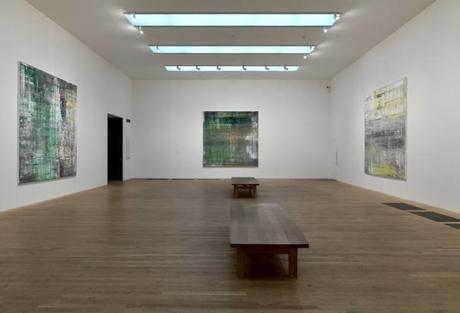I went to Tate Modern in London a few weeks ago to see Panorama - works by Gerhard Richter (now closed). As I said in an earlier post, I was a little disappointed and overall had a mixed reaction to his work.
His approach appears very intellectual. Even his dependence on chance in his 'squeegee' paintings does not appear to be for any sensual reason but academic.
The show is arranged chronologically. Much of the early work left me cold, especially the grisaille paintings made from photographs. The exception was the series of paintings about the Baader-Meinhof group. Somehow - for me anyway - the slightly detached coldness of these paintings chimed with the nihilism and the essential empty destructiveness of the groups ideology. For the rest though, nothing...
He clearly has great technical ability. Paintings like The Reader (1994) for example are photographic in their rendering, but I wonder then, as I always do with super-realist work, "What's the point?" Painting, for me at least, is not about capturing a likeness, although that may be an element. It must offer more than that, something I certainly cannot get from a photograph. In the case of a painting like Folding Dryer (1962) I don't get anything. Perhaps for Richter, fresh from East Germany, the abundance of consumer goods available to him in the West perhaps triggered something that led to this image, but away from that context it has no wider, universal meaning. I actually preferred a series of linocuts, Elbe from 1957. Made while still in the East these have an atmospheric quality, a depth, that the later monochrome works lack.
He also changes his style quite regularly. His gray paintings were followed by a series of color charts. These paintings, flat slabs of color arranged at random almost deny painting. There is no sense of brushwork or texture, no pretense o meaning, just flat rectangles of color. Comparisons might be drawn with the work of Bridget Riley, but Richter is not concerned with playing tricks with our visual cortex. He seems to be saying simply 'This is it, make of it what you like'.
Later he reverted to monochrome with among others, a series of Townscape paintings. These are Impressionist in technique, blobs of paint in shades of gray that only resolve into an image as you stand back.
By the 90s he is back working in color again. Some of these involve over-painting of photographs - seemingly arbitrary blotches of color ignoring, even destroying, the image beneath. He also begins to produce a series of Abstract Paintings, experimenting with the use of squeegees and building images through a process of adding and removing layers of paint. Most successful of these I think are a set of four, Forest from 1990, where the title is post hoc, based on the impression created by the paintings, rather than any prior intent.
By now his obsession with chance appears to be coming to the fore. Many paintings from this period include large areas where a layer of paint has been physically peeled off to reveal what is underneath in ways that can only be arbitrary. Others involve applying paint at random to paper then photographing it, selecting details and then painting at large scale those semi-random (in the sense that they were not planned, only selected) details. The technique adopted is however flat and soft, removing any sense of texture or impasto from the image, so that the final painting looks like nothing more than an brutally over enlarged digital image, albeit without the characteristic qualities of digital.
Finally, in this review at least, we come to the last pieces, a set of 6 paintings called Cage, so-named because they were painted while listening to the music of John Cage. These huge works, each 10 feet by 10 feet are wholly abstract, made by a process of layering over a period of weeks. Paint was added using huge squeegees. The monograph on the series shows a unique set of work in progress photos, that vividly demonstrates the way in which they changed and developed over time. I'm reserving judgment on these. Clearly they are a major piece of work, and in fact they have been acquired as a part of the Tate Permanent Collection. I'm unsure however whether there impact comes from any innate aesthetic quality as 'art' and how much comes from their sheer scale.

However, I am reminded of this quote from Sir Terry Frost, which I have used before in relation to the work of Mark Rothko.
"To look at a painting which gives you the opportunity to have solitude, to be yourself and to be able to wander into reverie, is more than hedonistic, it's spiritual".
Perhaps this quality of reverie will emerge the next time I see these paintings.

